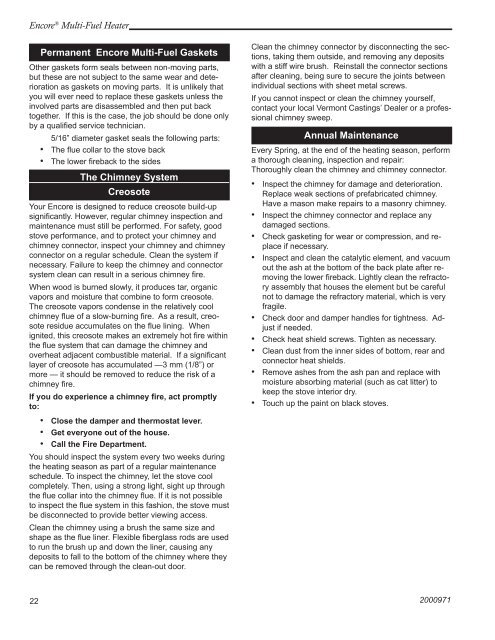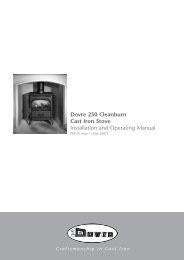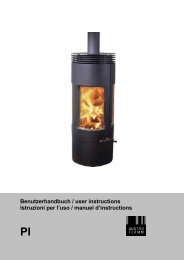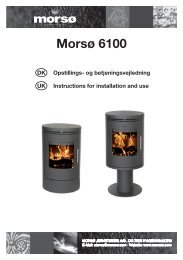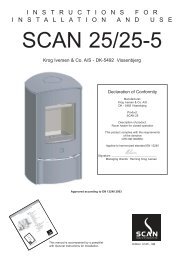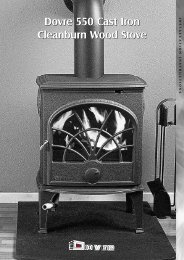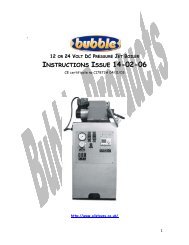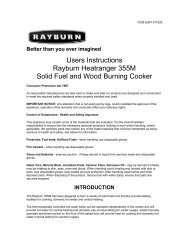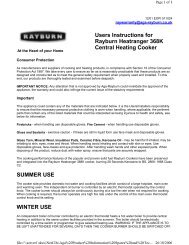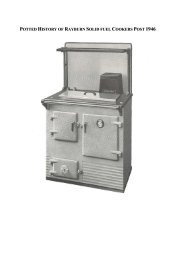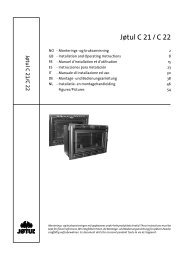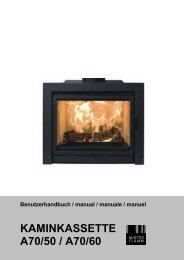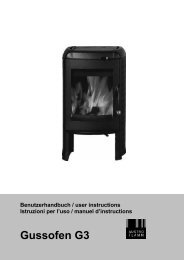Encore®
Encore®
Encore®
You also want an ePaper? Increase the reach of your titles
YUMPU automatically turns print PDFs into web optimized ePapers that Google loves.
Encore ® Multi-Fuel HeaterPermanent Encore Multi-Fuel GasketsOther gaskets form seals between non-moving parts,but these are not subject to the same wear and deteriorationas gaskets on moving parts. It is unlikely thatyou will ever need to replace these gaskets unless theinvolved parts are disassembled and then put backtogether. If this is the case, the job should be done onlyby a qualified service technician.5/16” diameter gasket seals the following parts:• The flue collar to the stove back• The lower fireback to the sidesThe Chimney SystemCreosoteYour Encore is designed to reduce creosote build-upsignificantly. However, regular chimney inspection andmaintenance must still be performed. For safety, goodstove performance, and to protect your chimney andchimney connector, inspect your chimney and chimneyconnector on a regular schedule. Clean the system ifnecessary. Failure to keep the chimney and connectorsystem clean can result in a serious chimney fire.When wood is burned slowly, it produces tar, organicvapors and moisture that combine to form creosote.The creosote vapors condense in the relatively coolchimney flue of a slow-burning fire. As a result, creosoteresidue accumulates on the flue lining. Whenignited, this creosote makes an extremely hot fire withinthe flue system that can damage the chimney andoverheat adjacent combustible material. If a significantlayer of creosote has accumulated —3 mm (1/8”) ormore — it should be removed to reduce the risk of achimney fire.If you do experience a chimney fire, act promptlyto:• Close the damper and thermostat lever.• Get everyone out of the house.• Call the Fire Department.You should inspect the system every two weeks duringthe heating season as part of a regular maintenanceschedule. To inspect the chimney, let the stove coolcompletely. Then, using a strong light, sight up throughthe flue collar into the chimney flue. If it is not possibleto inspect the flue system in this fashion, the stove mustbe disconnected to provide better viewing access.Clean the chimney using a brush the same size andshape as the flue liner. Flexible fiberglass rods are usedto run the brush up and down the liner, causing anydeposits to fall to the bottom of the chimney where theycan be removed through the clean-out door.Clean the chimney connector by disconnecting the sections,taking them outside, and removing any depositswith a stiff wire brush. Reinstall the connector sectionsafter cleaning, being sure to secure the joints betweenindividual sections with sheet metal screws.If you cannot inspect or clean the chimney yourself,contact your local Vermont Castings’ Dealer or a professionalchimney sweep.Annual MaintenanceEvery Spring, at the end of the heating season, performa thorough cleaning, inspection and repair:Thoroughly clean the chimney and chimney connector.• Inspect the chimney for damage and deterioration.Replace weak sections of prefabricated chimney.Have a mason make repairs to a masonry chimney.• Inspect the chimney connector and replace anydamaged sections.• Check gasketing for wear or compression, and replaceif necessary.• Inspect and clean the catalytic element, and vacuumout the ash at the bottom of the back plate after removingthe lower fireback. Lightly clean the refractoryassembly that houses the element but be carefulnot to damage the refractory material, which is veryfragile.• Check door and damper handles for tightness. Adjustif needed.• Check heat shield screws. Tighten as necessary.• Clean dust from the inner sides of bottom, rear andconnector heat shields.• Remove ashes from the ash pan and replace withmoisture absorbing material (such as cat litter) tokeep the stove interior dry.• Touch up the paint on black stoves.222000971


